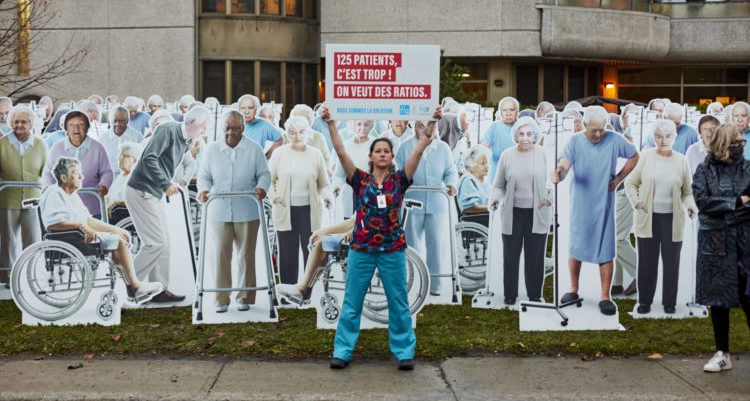
Quebec CHSLD rankings: Montérégie-Est gets top ranking for worst ratios
Faced with the government’s unwillingness to implement safe healthcare professional-to-patient ratios, especially in Quebec CHSLDs, the Fédération interprofessionnelle de la santé du Québec–FIQ and the FIQ | Secteur privé–FIQP are calling on the Premier and Health Minister. “There should never be another death toll like the one we saw in CHSLDs this spring due to COVID-19. The government needs to speed up discussions to decrease the work overload in order to guarantee safe, quality care to the population,” declared Nancy Bédard, FIQ President.
The FIQ and FIQP have released the rankings for the worst CHSLD ratios in Quebec and staged a demonstration of a typical situation healthcare professionals face on a daily basis. The action took place at the Centre d’hébergement René-Lévesque in Longueuil. Montérégie-Est ranks first for the worst healthcare professional-to-patient ratios, which the FIQ believes are dangerous for the population.
Over the last several years, the FIQ has demonstrated the importance of ratios. “In March 2018, healthcare professionals participated in 16 ratio pilot projects in healthcare institutions, including in several CHSLDs. Our members saw the positive effects of safe ratios on their practice conditions,” continued Ms. Bédard.
During the ratio projects, healthcare professionals observed better prevention of patient falls, better pain management, a decrease in the use of some medication, as well as less anxiety among patients and their families. They observed a significant increase in patients’ ability to walk, as well as better overall patient management, especially when complications or unforeseen problems arose.
Top regional rankings
The rankings demonstrate that the overall situation in Quebec isn’t pretty. For many regions, CHSLD ratios aren’t safe at all. Here are the top 3 CHSLDs with the worst ratios:
- The Centre d’hébergement Saint-Maurice in Mauricie/Centre du Québec with a ratio of 180 patients for 1 licensed practical nurse and 2 nurses (night shift).
- The Centre d’hébergement René-Lévesque in Montérégie-Est with a ratio of 224 patients for 2 licensed practical nurses and 1 nurse (night shift).
- The Manoir-Trinité in Montérégie-Est with a ratio of 119 patients for 1 licensed practical nurse (night shift).
For Brigitte Pétrie, President of the Syndicat des professionnelles en soins de la Montérégie-Est, the regional rankings are anything but joyful, as her region ranks worst. “Our members observe and suffer the daily consequences of having too many patients in their care. Today, Montérégie-Est healthcare professionals are joining all Quebec healthcare professionals in imploring the government to quickly improve their working conditions.”
A picture is worth a thousand words
The FIQ set up 125 mannequins to represent the number of CHSLD patients at the Centre d’hébergement René-Lévesque in Longueuil. Next, a healthcare professional enacted her duties, highlighting the work overload that comes with so many patients.
“The FIQ’s message is very clear—we no longer have to prove that ratios are absolutely key to enabling our members to provide proper care. How many personal accounts, facts and dramatic events will it take for the government to take action? What is it waiting for?! The situation is dire!” explained Nancy Bédard, FIQ President.
This demonstration will give the population and elected officials a good idea of what 125 CHSLD patients looks like so they can put themselves in healthcare professionals’ shoes. “They have an inhumane work load and enormous professional responsibilities. They have to make difficult decisions about which care to prioritize. This goes against their professional ethics and puts a burden on them that is too heavy to bear,” concluded Ms. Bédard.
Methodology
The rankings are based on CHSLD ratios between September 1 and 18. For each of the 306 Quebec CHSLDs where FIQ members work, both public and private, we calculated the average healthcare professional-to-patient ratios over day, evening and night shifts. The FIQ categorized the results per institution and region with colour coding to indicate the danger level of working conditions, going from “less problematic” to “highly dangerous.”